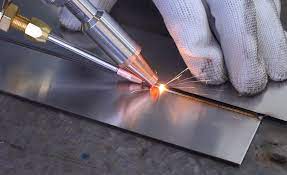This post will give you the complete rundown on laser welding equipment and how they operate, enabling you to make the best decision for your company.
What Is Laser Welding Machine?
Laser Welding Machine is a technology which Uses a laser beam to fuse metal components together. The laser beam is generated by a standalone laser source and directed onto the workpiece by a collimator “torch” that is either hand-held or placed on a machine. The workpieces (and filler rod, if necessary) are heated and melted by the focused energy beam, and the resulting melt pool fuses the targets together to produce a well-integrated weld.
Laser welding is advantageous because to its high accuracy and precise control over applied energy. With almost little overapplication or dispersion, the energy may be precisely focused to the exact spot where the weld is required. Compared to conventional welding techniques, it permits incredibly accurate liquefaction with a substantially reduced heat-affected zone. This lessens bulk heating and the resulting deformation, as well as causing less harm to the surrounding environment.
In addition to the electronics manufacturing sector, laser welding is widely employed in the automobile, aerospace, and medical industries. It is especially helpful for welding materials that are challenging to weld using conventional techniques, such aluminum.
What Is the Origin of Laser Welding?
The invention of laser welding began in the 1960s, nearly concurrent with the advancement of laser technology. Researchers at the US’s Bell Telephone Laboratories carried out the first laser welding trials. Using a ruby laser and brief, high-intensity energy pulses applied in coherent beams, the first laser welds were created. The metals melted and flowed together when pulses were concentrated onto a tiny area near the intersection of metal pieces. This produced extremely fine and thin welds with little distortion and heat-affected zones (HAZ) even in these early trials. It even showed some aptitude for fusing disparate elements together.
How Does Laser Welding Work?
Using a concentrated, collimated, high-intensity light beam, laser welding is a process that melts and fuses metal components, occasionally adding extra material from a filler rod. The procedure produces laser light, which is subsequently directed into an optical head or collimator. It is then directed towards the metal components’ junction, where it results in a limited melt pool and intensely confined heat accumulation.
Usually, a solid-state, fiber, or CO2 laser—each with certain benefits—generates the laser welding beam. The metal melts at the focal point of the beam, creating a small pool into which the filler rod may be melted as needed. The joint’s surface is then traversed by the laser beam. As a result, the pool’s leading edge melts and its fused, molten trailing edge cools and solidifies. When a weld is effective, the cooled metal fuses to both pieces almost equally and doesn’t oxidize.
Types of Laser Welding
- Heat conduction welding
The laser beam warms the material surface over the melting point during heat conduction welding. The method is employed to create welds for which a high weld strength is not necessary. For this kind of welding, a low power laser that is less than 500W is used. Smooth and beautiful welds are produced by heat conduction welding.
- Keyhole welding
When keyhole welding, the laser beam penetrates deeply into the material by heating the surface to the point of vaporization. This produces a keyhole in a state similar to plasma. The mercury crosses the 10,000K mark. This kind of welding uses a high-power laser that produces more than 105W/mm2.
What Is the Laser Welding Process?
The general steps involved in laser welding are as follows:
- Parts that need to be welded should be cleaned and precisely positioned. To enhance the quality of the weld, the contact line needs to be closed and gap-free.
- To hold items in position and keep them stable during the welding process, use automated fixtures or hand clamps.
- Ajust the focus point of the beam to the welding region. The welding torch’s optical gear often makes focus adjustment simple.
- Test the beam power on trial pieces and scrap material after adjusting it. Make sure it is emitting enough energy to melt the material but not enough to overheat parts before going on to the workpiece.
- At the beginning of the welding region, apply the beam. Once the proper melt pool has developed, it has to be moved steadily down the weld. Hot point rotation is one of the traditional welding procedures that will promote excellent fusion and enhance the quality of the weld.
- When the welding process is finished, let the component cool normally. with addition, you can utilize additional cooling techniques or quench it with water.
